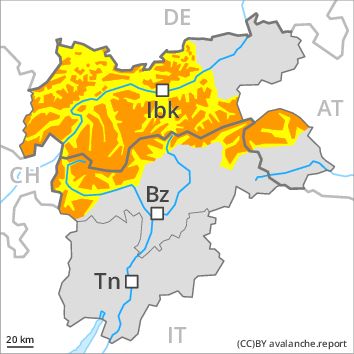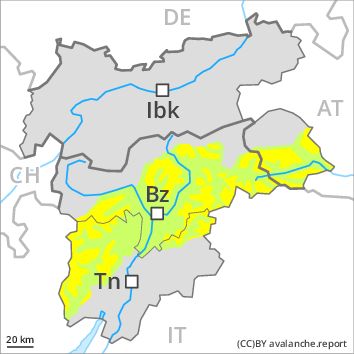Regions
Val Müstair Alps, Western Verwall Mountains, Langtaufers, Eastern Verwall Mountains, Schnals Ridge, Silvretta, Southern Stubai Alps, Samnaun Mountains, Southern Zillertal Alps and High Tauern, Northern Oetz and Stubai Alps, Saldurn-Mastaun Ridge, Western Tuxer Alps, Texel Mountains, Eastern Tuxer Alps, Glockturm Range, Durreck Range, Weißkugel Range, Western Rieserferner Mountains, Gurgler Range, Central Stubai Alps, Ortler Range, Northern Zillertal Alps, Allgäu Alps, Venediger Range, Eastern Lechtal Alps - Ammergau Alps, Mieming Mountains, Eastern Rieserferner Mountains, Karwendel Mountains, Glockner Range, Western Lechtal Alps, Central Lechtal Alps, Grieskogel Mountains

Danger level
Avalanche Problem
Wind-drifted snow above 2300m, N-NE-NW
Persistent weak layer above 2800m above 2300m, N-NE-E-W-NW

Wind slabs represent the main danger. Weakly bonded old snow requires caution.
Somewhat older wind slabs can be released by a single winter sport participant in some cases on very steep shady slopes above approximately 2300 m. Mostly the avalanches are medium-sized.
Dry avalanches can additionally in some places be released in the old snowpack, mostly by large additional loads. This applies in particular on very steep west, north and east facing slopes between approximately 2300 and 2800 m in little used backcountry terrain. In particular at transitions from a shallow to a deep snowpack avalanches can be released in the old snow and reach large size in isolated cases.
As a consequence of solar radiation individual natural loose snow slides are possible in the afternoon. Individual avalanche prone locations for gliding avalanches are to be found on steep grassy slopes below approximately 2500 m.
Snowpack
dp 6: cold, loose snow and wind
dp 7: snow-poor zones in snow-rich surrounding
The more recent wind slabs have settled a little.
Faceted weak layers exist in the old snowpack in particular on west, north and east facing slopes. This applies in particular between approximately 2300 and 2800 m.
The snowpack will be subject to considerable local variations. The old snowpack will be wet all the way through below approximately 2300 m.
Tendency
Further decrease in avalanche danger.
